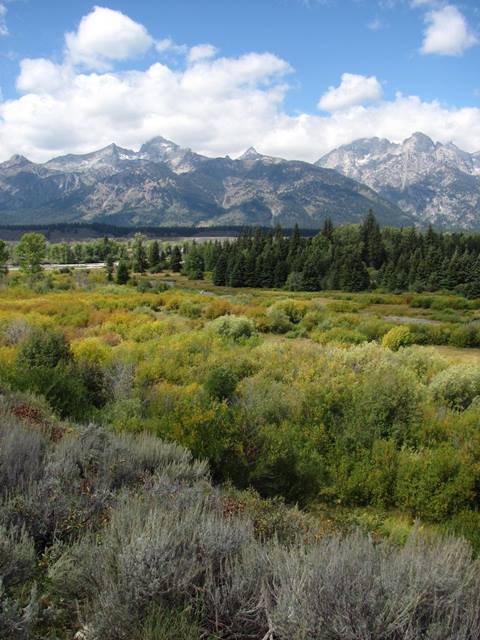#Laurance Rockefeller
Text
First stop, Grand Tetons. We spent our first night in the town of Jackson. We had a nice dinner at a restaurant called Gather and then ended up taking the Gondola up Snow King Mountain and saw a concert - the headliner was the Boulder, Colorado band Motet - it was fun and the sunset views from the top of the mountain were great. We spent Day 2 seeing some highlights of Grand Teton Park including Mormon Row, the Church of the Transfiguration, and Laurance S. Rockefeller preserve. We had lunch at Jenny Lake Lodge. Day 3 we took an early morning boat shuttle across Jenny Lake and hiked to Hidden Falls, Inspiration Point, and hiked Cascade Canyon trail to the Forks. We saw several moose on the trail. We stayed 2 nights in an adorable cabin in Colter Bay. Photos below include a Barbie Gondola (we just missed getting it!), Concert at top of Snow Mountain - Motet!, sunset from top of snow mountain, Miller Cabin out building with Tetons in distance, Mormon Row barn, Mormon Row wagon, Jenny lake Lodge front porch, Tetons, Church of the Transfiguration, and Laurance S. Rockefeller Preserve.


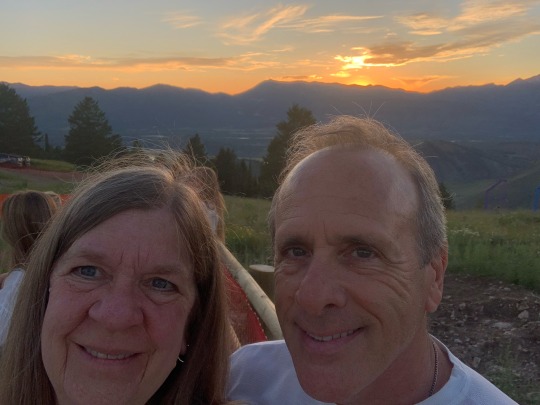

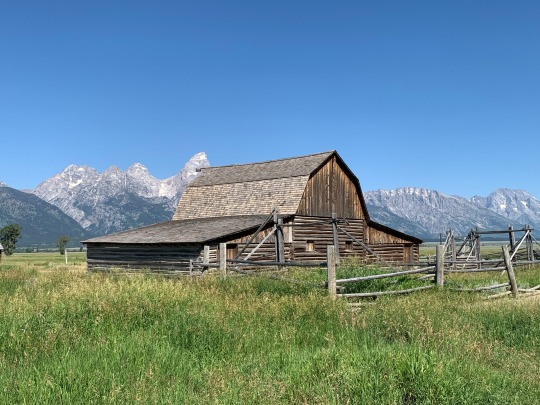
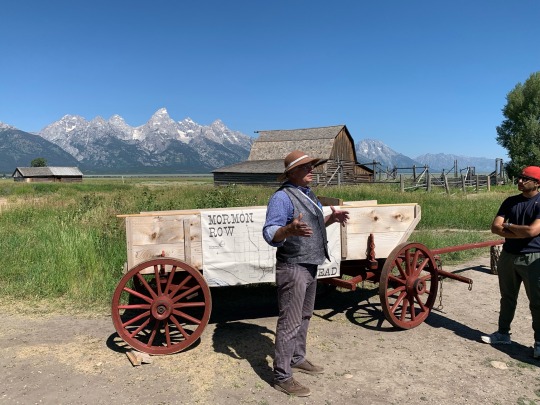

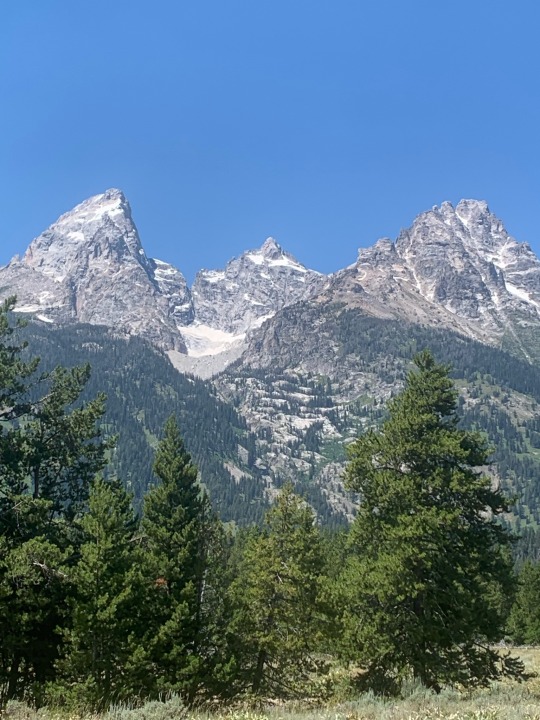

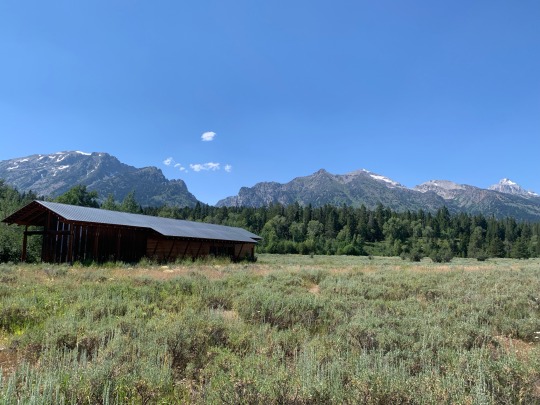
2 notes
·
View notes
Text

Fly fishers walk toward a stream in Grand Teton National Park, Wyoming, as the jagged mountains for which the park is named rise in the distance. Grand Teton draws both adventurers, for activities like mountain climbing and backcountry skiing, and leisure travelers, for boating, hiking, and fishing. Photograph By Aaron Huey, National Geographic Image Collection
How to visit Grand Teton National Park!
With Soaring Mountains and Braided Rivers, this Wyoming Park Epitomizes the American West. Here’s What You Need to Plan the Ultimate Trip.
— May 09, 2023
Fast Facts:
Location: Wyoming
Established: February 26, 1929
Size: 310,000 acres
Annual Visitors: About 2.8 million in 2022
Visitor Centers: All four are open from spring to fall; check the website for specific dates. Every center except the Laurance S. Rockefeller Preserve Center issues backcountry and boat permits. Flagg Ranch Information Station is a helpful trip planning stop, when entering from the south end of Yellowstone National Park.
Entrance Fee: Per vehicle and individual; annual passes available
Sharpened by glaciers, Grand Teton National Park’s snow-etched mountains erupt above Jackson Hole valley, composing one of the most iconic views in the country. “The Tetons rise to over 13,000 feet in a matter of miles. Just seeing that makes you feel humble,” says Vasu Sojitra, a professional athlete and disability access advocate, who completed the first disabled ascent on crutches of the Grand Teton in 2014.
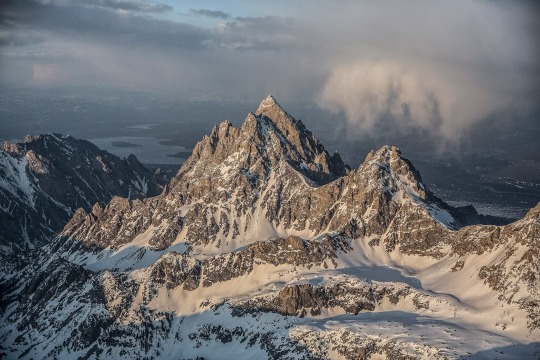
The towering granite crags of the Grand Teton range have drawn mountaineers, hikers, and photographers to this Wyoming park. Photograph By Jimmy Chin, National Geographic Image Collection
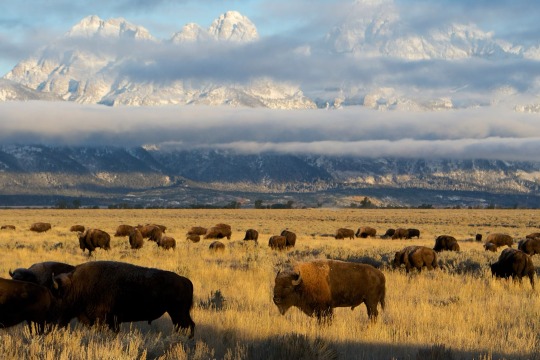

Left: Clouds drift above a herd of bison grazing in a valley in Grand Teton National Park. Visitors can also spot moose, bald eagles, ospreys, and pikas. Photograph By Barrett Hedges, National Geographic Image Collection. Right: In the fall, quaking aspen trees bring golden color to Grand Teton National Park. Photograph By Tom Murphy, National Geographic Image Collection
Some 200 years ago these majestic mountains were called Pilot Knobs by fur trappers because they could be seen from miles away. One of the Tetons’ tallest peaks, Teewinot, meaning “many pinnacles” in the Shoshone language, references the region’s ancestral roots. The 1800s homesteading tradition in the nearby town of Jackson gives the valley its moniker “The Last of the Old West.” Gazing out at verdant plains, towering crags, and fields of lemon-yellow balsamroot blooms, visitors understand why the park has become an emblem of the American West.
Why Go
Adventure athletes travel to the park to climb historic mountaineering routes, backpack into wildflower-strewn basins, or ski down advanced backcountry slopes in winter. But the park is also ideal for leisurely activities like biking, photography, and canoeing—set against the backdrop of the meandering Snake River, numerous lakes and streams, and the Grand Teton range.

Although a fraction of the size of nearby Yellowstone National Park, Grand Teton offers equally dramatic mountain vistas and impressive wildlife viewing. Outdoor photographer and Jackson local Steven Shelesky says it’s common to see wildlife, including elk, moose, pronghorn, and bison, while simply driving through the park.
Best Views
Shelesky says getting up early to catch a sunrise in the park is well worth the effort. “The entire Teton range is east facing, which makes for an amazing spectacle,” he says. Located about 350 yards from the parking lot, Schwabacher Landing offers particularly memorable views of a beaver pond off the Snake River. “You can see beautiful reflections of the Grand Teton on the water’s surface,” says Shelesky.

Sunset casts a rosy glow on the Snake River, in Grand Teton National Park, where families can go on scenic rafting tours. Photograph By Keith Ladzinski, National Geographic Image Collection
Nearby, the Snake River Overlook is another vista Shelesky recommends. The famous viewpoint captured by photographer Ansel Adams in 1942 highlights the curving river framed by the towering Tetons. Look for the Snake River Overlook turnout sign off Highway 191/89.
Best Hikes
Beginning at the Taggart Lake Trailhead on Teton Park Road, Taggart Lake is an easy hike that leads to a gorgeous lakeside picnic spot, where the Tetons reflect in the water. The three-mile round-trip trail rises just over 300 feet as it crosses bridges and weaves through a grove of quaking aspen trees, whose leaves tremble at the slightest breeze. For a more moderate hike, it’s well worth the extra steps to tack on the Taggart Lake-Bradley Lake Loop, which takes you 5.6 miles to both lakes. Both trails are also popular snowshoeing routes in winter.
Hikers looking for a more challenging route can follow the roaring Cascade Creek up the Forks of Cascade Canyon trail, where the glacially carved landscape leads to numerous viewpoints, including Inspiration Point and Hidden Falls. The 9.8-mile out-and-back route can be made more challenging during the day or as part of an overnight trip (permits required), by trekking 14.1 miles to Lake Solitude. You can book a round-trip ticket on the Jenny Lake Shuttle Service to avoid hiking an extra four miles roundtrip.
Best Drives
Teton Park Road and Highway 191/89/26 make a 42-mile loop that takes you to several pullouts and viewing sites in the park. Signal Hill Mountain Summit Road winds to the top of Signal Hill (nearly a thousand feet), where you’ll find two overlooks of the plunging Jackson Hole valley. The narrow road is five miles long and closed during winter.
Wildlife Spotting
Whether you’re on the slopes of Mt. Moran or canoeing Jackson Lake, wildlife abounds in Grand Teton National Park. Find elk and pronghorn in the sharp sagebrush of Timbered Island, just south of the Jenny Lake Visitor Center. Bison and moose roam the woods near various overlooks including Oxbow Bend along the Snake River, while bald eagles and osprey circle the sky.
Climb up the glacially carved Cascade Canyon trail and look for yellow-bellied marmots as you listen for the high-pitched chirp of pikas, a small lagomorph related to rabbits and hares. You just might see them collecting wildflowers and grass, which they store in hay piles for cold, snowy winters.
One of the park’s greatest attributes is its wildlife. To ensure your safety and theirs, obey the law requiring visitors to stay at least a hundred yards from bears and wolves and 25 yards from all other wildlife, including bison, moose, and pronghorn.
Posted speed limits are especially important in Grand Teton, which has seen increased wildlife collisions since 2000. Park officials advise extra caution during the fall, when animals migrate, and during low-light hours at dawn, dusk, and nighttime, when the speed limit is 45 miles per hour.
Visit Like a National Geographic Explorer
Wildlife biologist and National Geographic Explorer Autumn Iverson recommends getting an early start in Grand Teton. “Early in the morning is when birds and other wildlife are going to be more active,” says Iverson, whose work focuses on Brewer’s sparrows, a small songbird with a distinct call that lives in sagebrush. During her many field trips at dawn, she often saw elk, moose, and pronghorn, the second fastest land animal in the world.

Top: Researchers count lodgepole pine seedlings near Flagg Ranch, where the 2016 Berry Fire—the largest in national park history—burned forests that were about 150 years old. Photograph By Sofia Jaramillo, National Geographic Image Collection. Bottom: Ski mountaineers trek up the crest on Mount Owen in Grand Teton National Park. Outfitters such as Exum Mountain Guides and Jackson Hole Mountain Guides lead visitors up into the Tetons in winter and summer. Photograph By Jimmy Chin, National Geographic Image Collection

Jackson Lake glimmers like a black-and-white photograph in the winter. The lake is a popular spot for ranger-led programs, wildlife spotting, and canoeing. Signal Mountain Lodge is located on these shores.

Jackson Lake glimmers like a black-and-white photograph in the winter. The lake is a popular spot for ranger-led programs, wildlife spotting, and canoeing. Signal Mountain Lodge is located on these shores. Photograph By Michael K. Nichols, National Geographic Image Collection
Iverson says she particularly enjoyed paddling one of the many lakes. That’s when “you get this whole expansive view of everything around you,” she says. Visitors can rent canoes or kayaks from Signal Mountain Marina and the Colter Bay Marina, among other outfitters. Paddling is generally recommended in the morning before afternoon winds arrive.
Activities and Excursions
The Tetons are a steep mountain range that have attracted mountaineers and climbers like Irene Ortenburger and Yvon Chouinard. Because of their steep pitch and high elevation, many of the park’s high-altitude trails may be inaccessible for the first-time hiker.
Experienced hikers are drawn to the park for its challenging backpacking routes, including the sought-after Teton Crest Trail, which follows the range’s spine through wildflower-filled peaks from Teton Pass to String Lake. Totaling 40 miles, the trail generally takes backpackers three to five days to complete. Apply for a permit six months in advance on Recreation.gov.
Ambitious hikers and mountaineers may opt for a multiday trip in the backcountry to make summit attempts on the coveted 13,775-foot Grand Teton. Exum Mountain Guides and Jackson Hole Mountain Guides lead visitors up the lofty peaks in summer and offer ski mountaineering trips throughout the winter.
Best For Families
From mid-June to September, the park puts on various complimentary interpretive programs, which generally occur at Jackson Lake Lodge, Colter Bay Village, and Headwaters Lodge and Cabins. Jackson Lake Lodge’s naturalist programs illuminate the world of wildlife in the park, including birds of prey, mountain lions, and grizzly bears. Ranger-led hikes, wildlife viewing, and campfire talks occur daily in the summer throughout the park at its many visitor centers. Check the event calendar for the latest listings.
Outfitters like Solitude Float Trips or National Park Float Trips guide families on scenic rafting tours on the Snake River. Rafts generally put in at Deadmans Bar and take two to three hours to float 10 miles to Moose Landing, passing through a mellow stretch of the river. Knowledgeable guides educate guests on the park’s history and point out fauna, including white pelicans, beavers, and bison. Fall can be particularly picturesque, when rafts float by quaking aspen trees studded with golden leaves and stately Colorado blue spruce.
Where To Stay
There are eight campgrounds and seven lodges within the park’s boundaries. Stay on the glimmering shores of Jackson Lake at the upscale Signal Mountain Lodge or find a more rustic option at American Alpine Club Grand Teton Climbers’ Ranch, which hosts communal cabins popular with climbers and other outdoor enthusiasts. The National Park Service lists more options on its website.
Campers have over a thousand sites to choose from, ranging from $10 to just over $100 per night. Book six months in advance through Recreation.gov. Colter Bay Tent Village has 66 “tent cabins” with wood walls and canvas tent roofs. The small cabins include covered porches, bunk beds, and wood-burning stoves.
Note that all lodges, cabins, and campsites within the park close during the winter, but there are plenty of options in the bustling town of Jackson. About 13 miles from the park’s Moose entrance, Jackson has numerous restaurants, historic hotels, and live music venues.
You can also find lodging in Teton Village at the base of Jackson Hole Mountain resort. The charming area is just under two miles from the park’s southern Granite Canyon entrance, making it a great basecamp for skiers.

The Milky Way glitters over the Grand Teton mountain range, in Wyoming. Photograph By Babak Tafreshi, National Geographic Image Collection
Need to know
The park is located in northwest Wyoming near the border of eastern Idaho, accessible via three entrances: Granite Canyon, Moose, and Moran Junction. Since Grand Teton is connected to Yellowstone National Park by the John D. Rockefeller, Jr. Memorial Parkway, most visitors tack Grand Teton onto a multiday trip to Yellowstone.
July and August are the most popular times to visit Grand Teton. May, September, and October see fewer crowds and cooler temperatures. Although wintertime shuts down many amenities and roads, it’s a great time to experience the region by snowshoe, cross-country skis, or snowmobile.
Spring can be an especially nice time to visit when portions of Teton Park Road open for a short time to cyclists, inline skaters, and other recreationists before cars are permitted in May. Before your trip, check the park’s alerts and current conditions page for road closures.
General Tips
Weather changes quickly in the Rocky Mountains, especially in the summer. Always pack extra layers and a rain jacket on all outdoor excursions. When venturing into the high country, start early so you can get below the treeline by noon, thereby avoiding afternoon thunderstorms, which can be violent.
Grand Teton National Park is black and grizzly bear country. The National Park Service recommends hikers carry bear spray, a non-lethal deterrent that’s EPA-approved.
Accessibility
While some visitor centers, campsites, and lodges are accessible, there aren’t many trails for wheelchair and other medical aid users, says Vasu Sojitra, the disability access advocate. He notes that the North Pathway, a 20-mile paved trail that connects Jackson, Wyoming, with the park at Jenny Lake, is one of the more accessible areas in the region. “It is a really great way to experience and make a bigger day out of visiting the park,” he says.
#United States 🇺🇸#National Parks 🏞️#Grand Teton National Park 🏞️#National Geographic#Rocky Mountains ⛰️#Ultimate Trip#American 🇺🇸 West
4 notes
·
View notes
Text
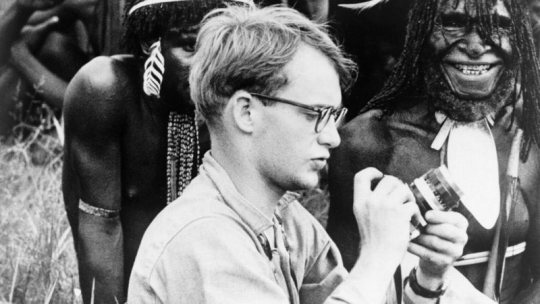
De como Michael, filho caçula do ex-presidente dos Estados Unidos Nelson Rockefeller, foi devorado vivo por canibais
Por Cláudio Tsuyoshi Suenaga
John Davison Rockefeller (1839-1937), o homem mais rico da história, fundador em 1870 da Standard Oil Company, o primeiro grande truste, foi o primeiro norte-americano a juntar mais de US$ 1 bilhão. Em 1937 sua fortuna com petróleo, bancos e indústrias chegou a US$ 1,4 bilhão, o que atualmente corresponde a cerca de US$ 664 bilhões. John D. teve cinco filhos: David, Nelson, Winthrop, Laurance e John D. III.

John Davison Rockefeller

A família Rockefeller (Michael está de pé, na extrema direita, e seu pai Nelson está sentado logo à frente). Keystone / Arquivo Hulton / Getty Imagens.
O sobrenome Rockefeller virou sinônimo de riqueza e opulência, de magnitude e poder, de dinastia perpétua e de cabala secreta, a invocar reverência e medo em todo o mundo. Ou melhor, em todo o mundo civilizado. Em novembro de 1961, o jovem etnógrafo Michael Clark Rockefeller, filho mais novo de Nelson Aldrich Rockefeller (1908-1979), então governador de Nova York (1959-1973) e futuro vice-presidente dos Estados Unidos (1974-1977), decidiu se aventurar em um dos poucos lugares onde sua fama e fortuna não significavam nada: Asmat, na costa sudoeste da Nova Guiné Holandesa, que agora faz parte da província indonésia de Papua.
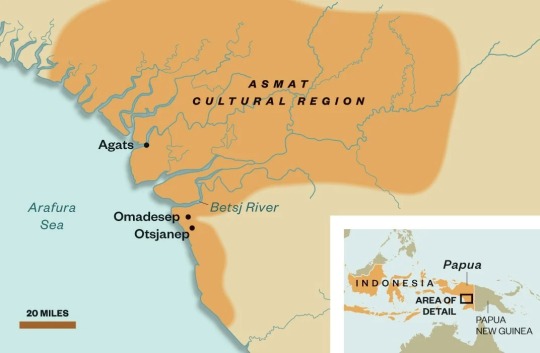
Mapa da região de Asmat, na Nova Guiné Ocidental. Autor: Guilbert Gates.
Michael, colecionador de arte primitiva, foi ao encontro de um dos povos mais atrasados do planeta, os Asmat, que como descreveu o The Washington Post, eram “os últimos puros caçadores-coletores na Terra, sem culturas de cultivo de alimentos além do sagu que eles misturam com pedaços de qualquer peixe ou carne que possam matar.”
Formado com louvor na Universidade de Harvard, em 1960 Michael serviu por seis meses como soldado no Exército dos Estados Unidos, e no ano seguinte juntou-se à expedição do Museu Peabody de Arqueologia e Etnologia de Harvard para estudar a tribo Dani, povo das terras altas centrais do oeste da Nova Guiné Holandesa.

As viagens de Michael Rockefeller para a Nova Guiné acabaram por levá-lo além do alcance de sua afortunada família. Foto da Associated Press.
Como membro da expedição Harvard-Peabody, o antropólogo e documentarista norte-americano Robert Grosvenor Gardner (1925-2014) filmou os Dani do Vale do Rio Baliem e com base nesse material lançou em 1963 o documentário Dead Birds. “Pássaros mortos” são termos que os Dani usam para as armas e ornamentos retirados do inimigo durante a batalha. Esses troféus são exibidos durante a dança da vitória de dois dias depois que um inimigo é morto.
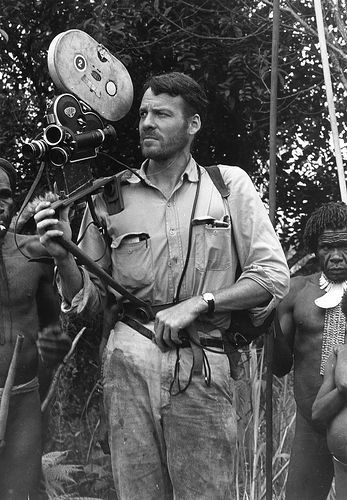
Robert Grosvenor Gardner
Michael e um amigo deixaram brevemente a expedição Harvard-Peabody para estudar a tribo Asmat, e depois de se juntarem novamente à expedição, Michael retornou à tribo Asmat para estudá-la melhor e recolher material etnográfico.
Em 17 de novembro de 1961, Michael Rockefeller e o antropólogo holandês René Sylvester Wassing (1927-2011), estavam em uma canoa de 12 metros a cerca de 3 milhas náuticas (6 quilômetros) da costa quando seu barco de pontão duplo foi inundado e virado. Seus dois guias locais nadaram para pedir ajuda, mas demoraram a chegar. Depois de dois dias à deriva, Rockefeller disse a Wassing: “Acho que consigo”. Ele então nadou para a costa. O barco estava a cerca de 12 milhas náuticas (22 km) da costa quando ele tentou nadar em segurança, no que supôs que ele teria morrido por exposição, exaustão ou afogamento.
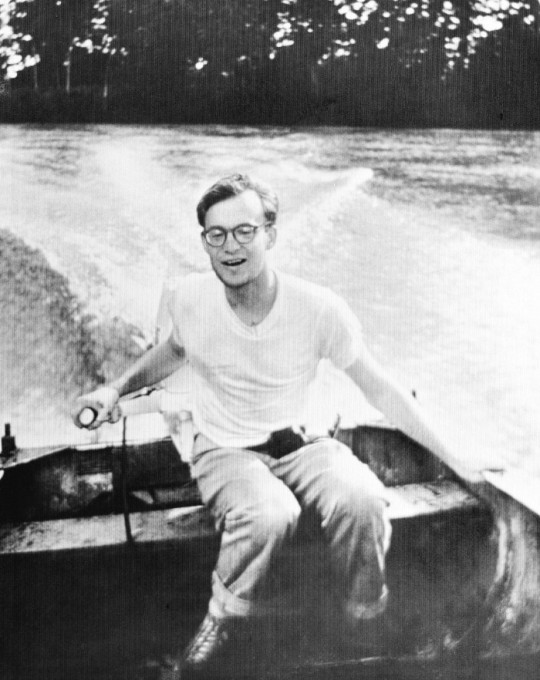
Michael Rockefeller operando um barco a motor de popa. Foto da Associated Press.

René Sylvester Wassing
Wassing foi resgatado no dia seguinte, mas Rockefeller nunca mais foi visto, apesar de um intenso e demorado esforço de busca. Na época, o desaparecimento de Rockefeller foi uma grande notícia mundial.
A versão oficial de sua morte foi a de que seu barco havia virado em um rio em Nova Guiné, no que se afogou ou foi atacado por um tubarão ou crocodilo de água salgada. Mas seu corpo nunca foi encontrado. No entanto, como a caça às cabeças e o canibalismo ainda estavam presentes em algumas áreas de Asmat em 1961, também houve especulações de que Rockefeller pudesse ter sido morto e comido por tribos da aldeia Asmat de Otsjanep.

Michael sendo "preparado para o banquete" pelo povo Asmat. Divulgação / Graveyard Shift.
Milt Machlin (1924-2004), editor da revista de aventura Argosy, decidiu estudar o caso pessoalmente e viajou à Nova Guiné em 1969 em busca de respostas para o enigma, baseando-se em um depoimento que afirmava que o jovem etnógrafo estava sendo mantido contra a sua vontade pela tribo Asmat. Foi durante seu tempo na Argosy que Machlin cunhou os consagrados termos “Triângulo das Bermudas”, para designar a área misteriosa no Oceano Atlântico em que barcos e aviões desaparecem, e “Abominável Homem das Neves”, para o Pé Grande ou Yeti.

Machlin apurou e filmou tudo o que era relacionado com o destino trágico de Rockefeller, e após sua viagem, publicou o livro The Search for Michael Rockefeller (Nova York, GP Putnam’s Sons, 1972),no qual ele concluiu que Michael chegou vivo à costa apenas para ser morto por caçadores de cabeças. Machlin descartou que Rockefeller estivesse vivendo como um cativo ou uma figura parecida com Kurtz na selva, mas constatou que a tribo praticava o canibalismo e recolheu evidências de que o próprio etnólogo tivesse vítima desse hábito. Ou seja, a pesquisa de campo em tribos primitivas tem um efeito colateral: o contato com seus hábitos menos civilizados.

Quatro anos após a morte de Machlin, o diretor, produtor, roteirista e ator Fraser Clarke Heston (1955-), filho dos atores Charlton Heston e Lydia Clarke, descobriu quinze rolos de filme de 16 milímetros da viagem de 1969, incluindo entrevistas de Machlin com missionários holandeses que viajaram de tribo em tribo e ouviram histórias que corroboravam a versão da morte do jovem nas mãos do povo aborígene em um ritual canibal macabro. Heston utilizou a filmagem para criar o documentário The Search for Michael Rockefeller (2010), mesmo título do livro de Machlin.

Vários líderes da vila de Otsjanep onde Rockefeller provavelmente teria ido se tivesse chegado à costa, foram mortos por uma patrulha holandesa em 1958, fornecendo assim alguma justificativa para a vingança da tribo contra alguém da “tribo branca”. E apenas dois anos antes, a guerra entre as tribos na região de Asmat resultou no ritual de caça às cabeças e canibalização de 51 adolescentes. Nem o canibalismo nem a caça a cabeças em Asmat eram indiscriminados, mas faziam parte de um ciclo de vingança olho por olho, de modo que é possível que Rockefeller tenha se tornado vítima inadvertida de tal ciclo.

Michael Rockefeller remando em uma canoa Asmat em 1961. Crédito: Associated Press.
O jovem jornalista australiano Paul Toohey foi até Nova Guiné Ocidental e conversou com dezenas de pessoas associadas ao caso, incluindo o detetive particular australiano Frank Monte, que foi contratado em 1979 pela mãe de Michael para tentar resolver o mistério de seu desaparecimento. Em seu livro Rocky Goes West (Australia, Duffy & Snellgrove, 1997), Toohey afirma que o investigador particular trocou um motor de barco pelos crânios dos três homens, todos europeus, que uma tribo alegou serem os únicos homens brancos que eles já mataram. O investigador voltou a Nova York e entregou esses crânios à família, convencido de que um deles era o crânio de Rockefeller. Se esse evento realmente ocorreu, a família nunca comentou nada a respeito.
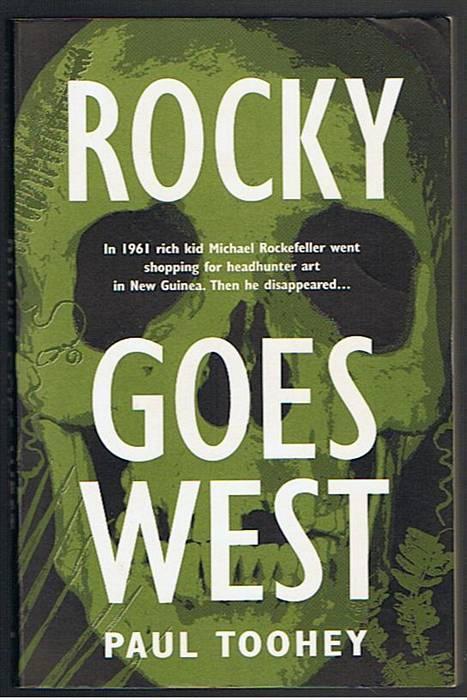
O artista, ativista e antropólogo norte-americano Tobias Schneebaum (1922-2005), não só conviveu na juventude por vários anos com os Asmat, como também com os Harakmbut, na região de Madre de Dios, perto da fronteira brasileira na Amazônia peruana. No documentário Keep the River on Your Right: A Modern Cannibal Tale (2000), dirigido pelos cineastas David Shapiro e Laurie Gwen Shapiro, que se basearam em seu breve livro de memórias publicado em 1969, Schneebaum, já idoso, revisita essas duas tribos canibais. Ele e os cineastas conseguiram localizar alguns dos membros da tribo Asmat de Otsjanep que ele conheceu durante esses períodos, e que descreveram terem encontrado Rockefeller na margem do rio e o comido.

O jornalista e escritor norte-americano Carl Hoffmann viajou pelo Afeganistão, Sudão, Congo, Nova Guiné, Groenlândia, Mongólia, Rússia, China, Indonésia e mais de 75 outros países. Ex-editor contribuinte das revistas National Geographic Traveler, Wired, Outside, Smithsonian, Men’s Journal, National Geographic Adventure e muitas outras, escreveu vários livros narrativos de não-ficção sobre suas próprias viagens e de outros viajantes e exploradores contemporâneos.

Carl Hoffmann em 2014
Hoffmann começou a pesquisar o desaparecimento de Michael Rockefeller em 2012 e dois anos depois lançou o livro Savage Harvest: A Tale of Cannibals, Colonialism, and Michael Rockefeller’s Tragic Quest for Primitive Art (New York, William Morrow, an imprint of HarperCollinsPublishers, 2014), em que confirma que Michael Rockefeller morreu devorado por quinze canibais como vingança por um massacre de indígenas quatro anos antes pelas mãos de “homens brancos”. Em suas incursões às aldeias da área, Hoffmann ouviu histórias semelhantes àquelas coletadas na década de 1960 sobre homens de Otsjanep discutindo e decidindo matar Michael depois que ele nadou até a praia, em vingança pelo referido incidente de 1958 no qual homens da aldeia foram mortos em um confronto com oficiais coloniais holandeses. Logo após o assassinato, as aldeias foram varridas por uma epidemia de cólera e os aldeões acreditaram que aquilo era um castigo por terem matado Rockefeller. Quando Hoffman deixou uma das aldeias pela última vez, ele testemunhou um homem representando uma cena em que alguém foi morto e parou para gravá-la.

Muitos dos artefatos Asmat coletados por Rockefeller fazem parte da coleção Michael C. Rockefeller Wing no Metropolitan Museum of Art em Nova York. O Museu Peabody publicou o catálogo de uma exposição de fotos tiradas por Rockefeller durante a expedição à Nova Guiné.
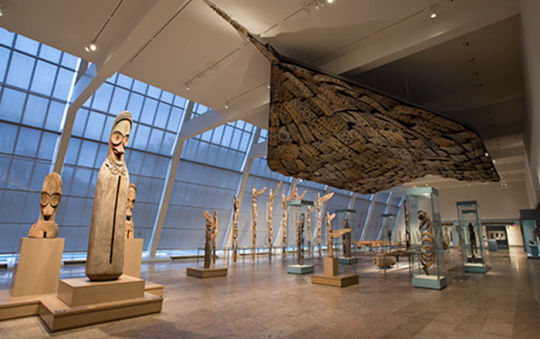
Michael C. Rockefeller Wing no Metropolitan Museum
Estaria Michael Rockefeller imbuído da missão de coletar bonecos de vodu para invocação de demônios?
O cineasta, diretor, produtor e conspiracionista britânico Christopher Everard, fundador do Enigma Channel, foi muito além dos pesquisadores citados e especulou em seu documentário Spiritworld, lançado em 2020, que Michael Rockefeller acabou involuntariamente devorado por canibais por conta de seus próprios pecados e de sua família, já que estaria entre os Asmat encarregada por ela de coletar artefatos e bonecos vodu que seriam usados para invocar demônios, os mesmos que os mantinham na posição de homens mais ricos e poderosos do planeta.
youtube
youtube
Os Rockefeller, assim como grande parte da elite satânica, segundo Everard, seriam seguidores de uma antiga tradição judaica-babilônica, na qual as riquezas são obtidas mediante o sacrifício de um de seus filhos. Everard revela em Spiritworld, que Nelson Rockefeller possuía a maior coleção de bonecos de vodu do mundo, e que seu filho foi comido vivo justamente enquanto tentava adquirir mais desses bonecos entre os Asmat. Seria isso apenas uma coincidência macabra, como também que o empresário escocês Andrew Carnegie (1835-1919), que como os Rockefeller foi o homem mais rico e poderoso de seu tempo, igualmente possuísse uma vasta coleção de bonecos vodu?

Andrew Carnegie, por Theodore Marceau
Everard lembra ainda que essa cabala pratica não só sacrifícios rituais de sangue, como o próprio canibalismo ritualizado, tais como aqueles registrados em cultos na Índia, Egito, França, Dinamarca, América Central e do Sul e em muitas outras nações desde o início da história até hoje.
Canibalismo em Arquivo X
“Our Town” foi um dos mais estranhos e obscuros episódios (o 24º do segundo ano) do seriado The X Files (Arquivo X, 1993-2002), criado por Chris Carter e produzido e exibido pela Fox Television. Tão estranho e obscuro que foi um dos dois episódios censurados (o outro havia sido “The Miracle Man”, o 17º do primeiro ano) pela Rede Record (de propriedade do bispo evangélico Edir Macedo, fundador e líder da Igreja Universal do Reino de Deus) no Brasil, que a exibia nas noites de domingo.

Roteirizado por Frank Spotnitz e dirigido por Rob Bowman, “Our Town” (que estreou em 12 de maio de 1995) abordava justamente o canibalismo, algo que não se enquadrava muito bem na infinidade de fenômenos sobrenaturais e inexplicáveis que caracterizava e costumava permear a série.
Os agentes especiais do FBI Fox Mulder (David Duchovny) e Dana Scully (Gillian Anderson) são enviados a Dudley, Arkansas, para investigar o caso do inspetor de saúde George Kearns, que havia sido assassinado na floresta por um sujeito empunhando um machado usando uma máscara tribal.

A dupla descobre que ele estava prestes a recomendar que uma fábrica de frango local, a Chaco Chicken, fosse fechada por violações de saúde. Enquanto faziam um tour pela fábrica, o gerente Jess Harold lhes diz que Kearns intentava prejudicar a Chaco Chicken. Depois de ouvir isso, uma alucinada operária da fábrica chamada Paula, agarra e segura Harold com uma faca. Mulder e Scully tentam argumentar com Paula até que ela é baleada e morta por Arens, o xerife local. O médico da fábrica, dr. Vance Randolph, mais tarde alude que Paula estava sofrendo de dores de cabeça constantes.
Os agentes vão ver Walter Chaco, avô de Paula e proprietário da fábrica, que permite que eles realizem uma autópsia, e nisso constatam que, embora ela tivesse 47 anos, não parecia ter mais de 20 e poucos. Eles também descobrem que Paula sofria da doença de Creutzfeldt-Jakob, uma doença neurodegenerativa rara e fatal na qual parasitas do tipo príon se encontram nos tecidos dos indivíduos infectados. O roteirista Spotnitz estava muito bem informado a respeito, pois o povo de Fore, na Nova Guiné, quase foi levado à extinção por uma doença que eles chamavam de Kuru, e que não era senão a doença de Creutzfeldt-Jakob, já que praticavam o canibalismo e se contaminavam ao comerem a carne uns dos outros. Aliás, para conceber o episódio, Spotnitz inspirou-se em parte na descoberta arqueológica de ossos humanos fervidos em Chaco Canyon, Novo México, tanto que deu o nome de “Chaco” à fábrica.
Quando os agentes notam o escoamento de sangue em um riacho próximo, Mulder ordena que o relutante xerife Arens a drague. Nisso encontram os ossos de nove pessoas, incluindo Kearns. Ao inspecionar os restos mortais, os agentes percebem que os crânios estão faltando e que os ossos parecem ter sido fervidos.

Ao consultarem os registros do FBI, Mulder e Scully descobrem que 87 pessoas desapareceram em um raio de 300 quilômetros de Dudley no último meio século. Mulder suspeita que os moradores da cidade estejam praticando canibalismo para prolongar a vida, dada a aparência jovem de Paula. Mulder também percebe que Kearns originalmente tinha a doença de Creutzfeldt-Jakob, e que os outros moradores pegaram a doença depois de consumirem seu corpo. Os agentes tentam pesquisar os registros de nascimento da cidade para confirmar a idade de Paula, mas descobrem que eles foram destruídos. Na mansão de Chaco, Chaco e Harold se encontram com Doris, que em lágrimas acusa Chaco de ter ajudado a matar seu marido; Chaco a instrui a obstruir a investigação do FBI.
Doris liga para Mulder, acreditando que Chaco quer matá-la; depois que ela desliga, ela é atacada pela figura mascarada. Scully vai ajudar Doris enquanto Mulder procura Chaco em sua mansão. Lá, ele encontra as cabeças encolhidas de Kearns e outras vítimas em um armário. Mulder telefona para Scully e a ouve sendo nocauteada por Chaco. Ela é levada para um campo isolado, onde Harold acende uma fogueira e inicia um ritual para canibalizar Doris. Chaco os repreende por matar um deles, mas Harold o recrimina por permitir que a epidemia de Creutzfeldt-Jakob tivesse se espalhado, e nisso Chaco é executado pela figura mascarada. A própria Scully está prestes a ser morta quando Mulder chega e atira na figura misteriosa. Por trás da máscara, estava o xerife Arens.
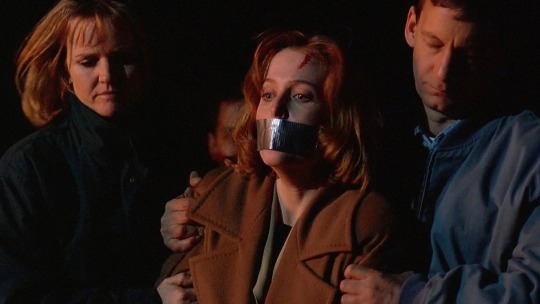
Na narração, Scully explica que a fábrica de Chaco foi fechada pelo Departamento de Agricultura, e que 27 moradores de Dudley morreram da doença de Creutzfeldt-Jakob. Ela revela que Chaco, que tinha 93 anos quando de sua morte, havia passado um tempo com a tribo canibal “Jale” depois que seu avião de transporte acabou abatido sobre a Nova Guiné durante a Segunda Guerra Mundial. Ela também diz que seus restos mortais nunca foram encontrados. A cena final sugere que os restos mortais de Chaco estão sendo dados às galinhas em sua fábrica...

Um pouco da história do canibalismo e de suas práticas rituais
O termo “canibalismo” se originou da corruptela da palavra “caribe” em “caniba” na língua taíno, da etnia Arawak. Para os Caribs, significava “ousado”, mas para os Arawak, inimigo”, e para os europeus, “comedores de carne humana”. Cristóvão Colombo reportou que os Caribs ou Caraíbas antilhanos, nativos que Cristóvão Colombo encontrou na ilha de Hispaniola em sua primeira viagem, praticavam antropofagia, e que atacavam os Arawaks para obter saques e capturar as crianças que depois castravam.

Caribs retratados como canibais.
Vestígios arqueológicos na Mesoamérica e na América do Sul indicam a prática de canibalismo. Uma das sociedades que mais desenvolveu essa prática foi a dos Guarani, que a praticavam para fins religiosos, por acreditar que era uma forma de adquirir certas capacidades e aptidões da vítima. Na América do Norte, análise de restos descobertos em sítios arqueológicos habitados entre 1150 e 1200 d.C. pelos Anasazi, confirmou a existência de canibalismo nesta cidade. Restos de hemoglobina humana foram encontrados nos vasos cerâmicos da cultura Anasazi, sugerindo que foram cozidos com sangue humano.

Ruínas do povo Anasazi.
De acordo com as narrativas dos conquistadores, a prática do canibalismo era comum entre os povos nativos aliados e adversários de Hernán Cortés em atos religiosos e após escaramuças, para as quais o sal era usado até mesmo nas batalhas para salgar os inimigos mortos, de modo que sua carne duraria mais e eles poderiam voltar com ela para suas aldeias e distribuí-la entre seus parentes. Entre a aristocracia asteca, o canibalismo era comumente praticado em rituais religiosos.
Em 14 de fevereiro de 1779 , o comandante da expedição naval inglesa James Cook e alguns de seus homens foram mortos e consumidos na baía de Kealakekua, no Havaí (embora ainda haja controvérsia sobre a certeza desse fato) pela população local, após uma tentativa malograda de sequestrar seu rei, em retaliação pelos roubos dos nativos.
Em 1809, os 66 passageiros e tripulantes do navio The Boyd foram mortos e comidos por Maoris na Península de Whangaroa da Ilha do Norte como parte de um utu (“vingança”) pela chicotada dada a um Maori que se recusou a trabalhar no navio durante a viagem da Austrália. O incidente continua sendo o maior massacre da história da Nova Zelândia.
O canibalismo ritual como oferenda aos deuses ou como forma de obter a força e a coragem do guerreiro inimigo sempre foi o mais praticado. O princípio simples que sustentava a antropofagia Guarani era que a pessoa acumula energia ao longo de sua existência, e que essa energia podia ser usada por outra pessoa para expandir a consciência. O objetivo vital dos Guarani era transcender os limites da existência cotidiana, acessando o que eles chamavam de “Terra Sem Mal”, um estado vital onde uma pessoa escapava do mal e até da morte (como supressão do nível físico da existência). Nesse contexto, consumir a personalidade de uma pessoa e seu corpo fisicamente, proporcionaria ao canibal um aumento de energia impossível de se obter por outros meios. Assim, os Guarani não comiam qualquer um, mas apenas os melhores.
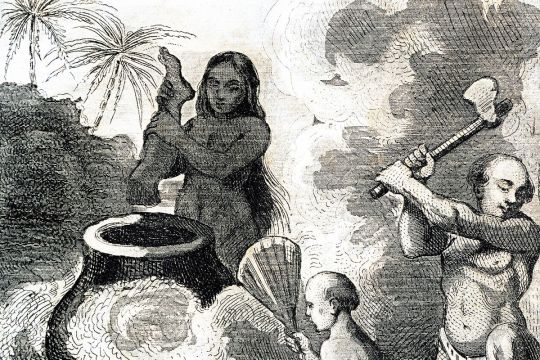
Uma gravura representando o canibalismo no Brasil. Imagens Getty.
A elite oculta sempre foi obcecada pelas práticas mais abomináveis, e o canibalismo sempre fez parte dessas práticas que visam absorver a força divina guardada dentro do corpos para com isso não só manterem, mas potencializarem ainda mais suas riquezas e seus poderes. E foi pela vontade de poder desmesurada e infinita de sua família, que Michael se sacrificou – ou foi sacrificado e comido – por ela.
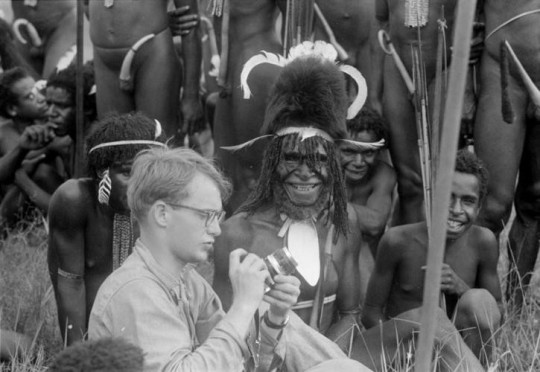
Uma das últimas fotos de Michael Rockefeller cercado pelos Asmat. Foto de Jan Broekhuijse.
#rockefeller#new guinea#antropologia#etnografia#exploração#aventuras#argosy#antropofagia#documentary#the x files#x files#our town
4 notes
·
View notes
Text
Laurance Rockefeller, John Podesta and Chester Bennington are not related | Reuters
https://www.reuters.com/article/idUSL1N36U2VQ/
View On WordPress
0 notes
Photo

Great price on this 2020-S Uncirculated Marsh Billings Rockefeller National Historical Park Quarter ONLY: $1.75 2020-S Uncirculated Marsh Billings Rockefeller National Historical Park QuarterThe Marsh-Billings-Rockefeller National Historical Park in Vermont is the only national park dedicated to telling the story of conservation history and the evolving nature of land stewardship in America. It was the boyhood home of George Perkins Marsh, one of America’s first conservationists, and later the home of Frederick Billings. The property was given to the American people by its most recent owners, Laurance S. and Mary French Rockefeller.The reverse (tails) design depicts a young girl completing the planting of a Norway spruce seedling near an established tree, continuing the life cycle of the forest. The child represents the conservationist, seeking to maintain a sustainable forest for future enjoyment and education. https://www.thecoinshop.shop/national-park-quarters/2020-s-uncirculated-marsh-billings-rockefeller-national-historical-park-quarter View MORE National Park Quarters https://www.thecoinshop.shop/national-park-quarters
0 notes
Text
La riunione
La riunione si svolse lì, in un attico di una villa americana. Le ragnatele che pendevano dalle travi, il filo polveroso di luce, le tante scatole e il poco spazio, facevano contrasto con i dieci uomini affollati lì dentro, ciascuno rappresentante un altro, che non ci sarebbe entrato per mancanza di spazio. Il contrasto era dovuto al fatto che questi uomini erano i dieci più ricchi d’America, abituati a bordi piscina e sedie rivestite di seta, ma erano lì, scomodamente seduti sugli scatoloni e nella polvere. Tra loro c’era Ronald Regan, l’attuale presidente, che prese la parola. “Allora, l’accordo c’è. Prenderemo di mira tutti coloro che possono influenzare gli altri nella società, con la loro fama, con il loro titolo, con la loro personalità. E loro promuoveranno prodotti, forzatamente, in gruppi divisi per area di esperienza. Nessuno potrà mai accorgersene, visto che viene naturale promuovere prodotti, nella società odierna. Saranno ospiti nei personal computer che venderemo in sempre maggiore misura, host, che leggeranno i pensieri sui prodotti delle persone per cui lavorano e porteranno i messaggi che abbiamo determinato, all’estremo.” Laurance Spelman Rockefeller, intervenì: “La competizione ci sarà, ma tutta secondo questi modelli, chi crescerà con essi non si accorgerà nemmeno della fine della fantasia, della fine del pensiero filosofico o intellettuale. Si studierà il passato, si imparerà il passato e tutti i nuovi modelli passeranno per noi”. Il Presidente rispose “sì, sarà totalitarismo nascosto, penetrante nelle idee, nel nucleo stesso del progresso. L’America così dominerà il mondo”.
John Howard Pew, proprietario di una compagnia di petrolio, prese un foglio. “È tutto qui speigato da W.C. Röntgen, I raggi X verranno inseriti negli edifici pubblici tramite il sistema di allarme antincendio. La sicurezza sarà il motivo per cui nessuno avrà dubbi a riguardo. Ovviamente contiamo che il popolo abbia le sue paure, e che ogni marchingegno che causa loro di sentirsi meglio sarà ben accetto, poi ci penseranno il cinema e i libri a rafforzare questo messaggio. I suddetti raggi si rifletteranno sugli schermi dei computer, contenenti un liquido che svilupperà gli impulsi organici degli altri, su una piastra che i nostri scelti saranno costretti a leggere. Naturalmente conosciamo le zone del cervello che si riferiscono agli oggetti o ai prodotti, per cui quelle saranno le dirette interessate. Il resto del tempo i computer li ascolteranno, e se viene menzionato un prodotto, andrà commentato. Gli schermi fondamentalmente serviranno a far promuovere prodotti, e mantenere la nostra industria ricca e potente.
I rumori stereo e l’odore di sapone saranno le uniche difese che queste persone avranno, dall’ascoltare costantemente i pensieri altrui sui prodotti. Se accenderanno la televisione, il rumore di essa bloccherà le loro percezioni, ma sarà solo per comprare commercialmente anche loro. L’unico modo di cacciare abbastanza raggi X per liberarli tutti, la abbiamo noi, la bomba nucleare, perché la potenza del rumore li disattiverebbe.
Le emozioni, il calore, i movimenti delle persone in una stanza creeranno pressione, e più ci sarà pressione più i raggi agiranno su di loro e sulla loro salute. Per cui impareranno presto a restare calmi e contenuti, a vivere parlando di prodotti e promozioni, per abbassare il livello dei raggi. Ci sarà dell’acqua mantenuta nelle case dalla tensione elettrica, che non rilasciata contribuirà a irradiarle”
Il presidente era d’accordo: “oramai il potere è nostro, oramai le bombe nucleari le abbiamo noi e l’Unione Sovietica verrà dominata da questo nuovo sistema.”
0 notes
Text
Beaches Around the World
Beaches Around the World
https://ift.tt/W4bLUak
It’s not easy to rank the world’s best beaches. Various factors can affect a traveler’s decision-making process when choosing a beach, such as the type of water sport they prefer, the safety of the environment, and the overall experience. However, we can still try!
These are some of the most beautiful beaches in the world, and you will have to share them with other travelers. If you want to experience the tranquil environment of a private island resort, consider visiting one of these stunning beaches.
Tulum, Riviera Maya, Mexico
This beautiful beach’s location also sets it apart from other places in Mexico. It’s only a couple of miles from some of the most astounding Mayan ruins in the country. The ruins of this ancient city are located on a rocky cliff, and it overlooks a spectacular beach. The number of tourists who visit this area every day keeps it from feeling too private, but the magnificent turquoise waters and white sand make it an ideal beach.
British Virgin Islands
The British Virgin Islands were on the beach holiday map in 1964 when Laurance Rockefeller opened Little Dix Bay, a luxurious resort on Virgin Gorda’s serene crescent of sand.
You can explore White Bay Beach on Jost Van Dyke in the British Virgin Islands. You can also visit Sandy Spit, uninhabited and remote, or The Baths National Park, which features a series of massive boulders that set the boundaries of calm pools.
Source d’Argent, Seychelles
The pink-colored sand at Source d’Argent, located on La Digue, Seychelles’ third-largest island, is an ideal addition to the beach. It’s also surrounded by massive granite boulders that set the shore. Several restaurants serve Creole-inspired food nearby.
Navagio Beach, Zakynthos, Greece
Located on the Greek island of Zakynthos, the Navagio beach is a beautiful sandy strip surrounded by limestone cliffs. It’s also referred to as the Shipwreck Beach. This is due to the wreck of a ship believed to have been a smuggling vessel. The area is known for its white sand beaches, clear blue water, and massive limestone cliffs. Although it’s only accessible by boat, the beach can be seen above.
Bermuda
Although you might not think that Bermuda’s beaches are white and black sand, they are filled with pink sand. This British overseas territory’s beaches are made up of foraminifera, tiny red-shelled organisms living in the sand. While there are a few white sand beaches in the country, the best spot to visit is Jobson’s Cove, surrounded by jagged limestone outcroppings. If you’re looking for history, head to St. Catherine’s Beach, where the first settlers came upon the wreck of the Sea Venture, which inspired William Shakespeare’s The Tempest.
The post Beaches Around the World first appeared on Lacey Flanagan | Travel.
via Lacey Flanagan | Travel https://ift.tt/6D1xsf9
May 02, 2023 at 11:30AM
0 notes
Text
Experience timeless elegance (and so much more!) at the Woodstock Inn
Experience timeless elegance (and so much more!) at the Woodstock Inn
Audubon effortlessly glided from a nearby perch, making a beeline for my heavily gloved arm. He snatched up the beef bit and then proceeded to use my limb as his throne, while the paparazzi took pictures. He knew he was a good-looking guy and soaked up the attention. Occasionally, he would eye me and engage in an intense staring contest. I was instantly smitten with this striking…

View On WordPress
#Billings Farm & Museum#Debbie Stone#Gillingham’s General Store#Kelly Way Gardens#Laurance Rockefeller#Marsh-Billings-Rockefeller National Historical Park#Middle Covered Bridge#New England Falconry#Quechee Gorge#Red Rooster#Richardson Tavern#Simon Pearce glass workshop#Vermont Maple Cake#Woodstock Inn & Resort
1 note
·
View note
Photo

Breakfast amongst the pines and aspen trees. Eggs and bacon on their plates, coffee percolating....what more could you ask for?
Haviland Lake Campground, Colorado 1962
FUN FACT:
1962 was the release of Outdoor Recreation for America : A Report to the President and to the Congress by the Outdoor Recreation Resources Review Commission, Laurance S. Rockefeller, Chairman, 1962: "It shall be the national policy, through the conservation and wise use of resources, to preserve, develop, and make accessible to all American people such quantity and quality of outdoor recreation as will be necessary and desirable for individual enjoyment and to assure the physical, cultural, and spiritual benefits of outdoor recreation."
#vintage camping#campfire lights#colorado#haviland lake#camping breakfast#outdoor recreation#laurance s rockefeller#1962#us history#national parks
37 notes
·
View notes
Text
Ölüm Tohumları Genetik Bilimin Arkasındaki Karanlık Oyunlar F. William Engdahl
Bilgilenmek için okuyun ve okutun bu kitabı.Kitabın ilk bölümünü okuduktan sonra çoğu okuyucunun dikkatini çekeceğine inandığım için ilk bölümü aşağıya bırakıyorum. "Biz dünya nüfusunun %6.3'ünü oluşturuyoruz ama zenginliğinin yarısına sahibiz. Bu farklılık özellikle bizler ve Asyalılar kadar büyük. Böyle bir durumda kıskanılma ve gücenilme gibi bir durumda olamayız. Gelecek dönemdeki asil görevimiz, ulusal güvenliğimize bir zarar getirmeden bu farklılık durumunu sürdürebileceğimiz bir ilişki kalıbı tasarlamaktır. Bunu yapmak için de tüm duygusallık ve hayallerden uzak durup dünyanın her yerindeki ulusal hedeflerimize odaklanmalıyız. Kendimizi çıkarlarımızdan fedakaarlık ederek dünyanın iyiliği için lüksümüzden vazgeçeceğimiz konusunda kandırmamıza hiç gerek yok." Seorge Kennan, 1948 Bu kitap küçük bir sosyo-politik elit zümre tarafından 2.Dünya Savaşı sonrasında Vaşington'da ele alınmış bir proje ile ilgilidir. Bu, Kennan'in "farklılık durumunu sürdürebilmek" tümcesinin nasıl hayata geçirildiğinin anlatılmamış hikâyesidir. Aynı zamanda bir avuç insanın savaş sonrası tüm kaynaklara ve güce sahip oluşunun da hikâyesidir. Bu, güç devrimi tarihinin de ötesindedir, hattâ bilim dâhi bu azınlığın hizmetine sokulmuştur. 1948'de Kennan'in da kendi notlarında tavsiye ettiği gibi, herhangi bir fedakârlık veya dünyanın iyiliği düşünülmeden acımasız politikalar uygulandı. Seleflerinin aksine İngiliz imparatorluğu içindeki hâkim guruplar, yeni beliren 'Amerikan eliti, kendilerini savaştan sonra, "Amerikan Yüzyılı"nın şafağında ilan ettiler ve hitap yeteneklerini, dünyanın iyiliği için düşüncesini kendi amaçlarına uygun şekilde kullandılar. Onların Amerikan Yüzyılı daha yumuşak ve kibar bir imparatorluk olarak sömürgecilikten kurtuluş, demokrasi, ekonomik gelişme ve özgürlük kisvesi altında diğer ulusların kaderlerine hükmedebilen, Büyük İskender'den sonraki en büyük küresel imparatorluktu. Bu kitap "Bir Savaş Yüzyılı: Anglo-Amerikan Petrol Politikaları ve Yeni Dünya Düzeni" adlı kitabın bir devamı niteliğindedir. Petrolden sonra ikinci bir "kırmızı hattı" takip eder. İnsanın yaşamını sürdürebilmesinde en temel ihtiyacı olan günlük ekmeğinin karşılanmasını konu alır. 70'ler boyunca bu Amerikan elitin menfaatine hizmet eden kişi, hayatı boyunca 'güç dengesi1 politikalarının bir uygulayıcısı olan Henry Kissinger'di. Ve dünya hâkimiyeti konusundaki şu fikrini açıklamıştır; "Petrolü kontrol edersen ulusları kontrol edersin, yiyeceği kontrol edersen insanları kontrol edersin." "Küresel yiyeceği kontrol etme plânı" 1930'ların başlarına, savaşın patlak vermesinden önceye dayanır. Bu organizasyon belli başlı bazı ailelerin servetlerini korumak amacıyla seçilmiş özel kuruluşların yardımlarıyla maddi olarak destek görmüştür. Bu aileler güç ve zenginliklerini doğu sahili boyunca Boston, Vaşington, New York ve Philedelphia'ya yerleştirmişti. Bu sebeple egemen medya kuruluşları sıkça onlara atıfta bulunmuş, zaman zaman alay konusu etmişlerse de genellikle övmüşlerdir. Savaşla birlikte Amerikan gücünün ağırlık merkezi doğu sahilinden Seattle, Houston, Las Vegas, Atlanta ve Miami gibi bölgelere dağıldı. Sonradan da Asya, Japonya ve Latin Amerika'ya. 2.Dünya savaşından bir süre önce bir aile diğerlerine göre daha fazla öne çıkmıştır. Bu ailenin serveti, uğruna kan dökülen ve savaşılan 'kara altın' petrole dayanıyordu. Bu aileyle ilgili olağandışı olan ise ailenin sadece petrole değil, diğer başka alanlarda da yatırım yapmaya karar vermesi olmuştur. Psikoloji, tıp, gençlerin eğitimi, tarım, biyoloji ve biyolojinin tarımsal uygulamalarına yatırım yapmışlardır. Çoğu kişinin fark etmediği devasa bir büyüme ve gelişme göstermişler, servetlerini de o ölçüde büyütmüşlerdir. Bu kitapta ele alınan ana konu olan 'genetiği değiştirilmiş organizmalar' ya da GDO'nun tarihi, dönemin güçlü ailelerinden olan Rockefeller ailesinin (ve 4 kardeşin - David, Nelson, John ve Laurance) tarihiyle paralellik göstermektedir -ki savaşın Amerikan zaferiyle bitmesinden sonraki 30 yıl süresince güç evrimine bu insanlar yön vermiştir. Gücün tamamı ellerindedir ancak işin maliyeti tüm dünyayı etkilemiştir. Bundan 30 yıl önce, erk Rockefeller ailesinin etrafında toplanmıştı. Bugün ise 4 kardeşin 3'ü çeşitli nedenlerle vefat etmiştir. Tüm amaçları, daha sonraları Pentagon'un 'tam spektrum egemenlik' adı vereceği, gerektiğinde askeri gücün de devreye sokulabileceği küresel hâkimiyetti. Projeleri o günlerdeki küçük bir güç gurubundan bugün hayal bile edemeyecekleri, tüm gezegenin geleceği hakkında inisiyatif sahibi oldukları bir noktaya evirildi. Kalıtım mühendisliği ile bitki ve diğer canlı organizmaların patentlenmesi tarihinin anlaşılabilmesi için 2.Dünya savaşını takip eden yıllardaki Amerikan gücünün dünyada nasıl yayıldığına bakmak gerekir. George Kennan, Henry Luce, Averell Harriman ve hepsinden önce Rockefeller kardeşlerin tarım sektöründe başlattığı 'yeşil devrim' sayesinde Petro-kimyasal gübre, petrol ve enerji ürünlerine bağımlılık arttı. Onların o günlerde yaptıkları bugünün genetiğini değiştirme tarihinin ayrılmaz bir parçasıdır. Yüzyılın başında gerçekleşen 4 çokuluslu dev şirket birleşerek dünya üzerindeki çoğu insanın temel besinlerinin (pirinç, soya fasulyesi, buğday, mısır ve hatta bazı sebze ve meyveler ile pamuk) kontrolünü ellerine geçirdiler. Hastalığa dayanıklı kümes ürünleri, genetiği değiştirilmiş, güya kuş gribine dayanıklı ürünler ve geni değiştirilmiş domuz ve sığır üretimi için çaba sarf etmişlerdir. Dört özel şirketin üçünün Pentagonla kimyasal savaş araştırmaları konusunda sıkı bağları vardı. Dördüncü şirket aslen İsviçre kökenli olmasına rağmen İngiliz kontrolü altındaydı. Petrolde olduğu gibi GDO tarım projesi de bir Anglo-Amerikan küresel plânıdır. Mayıs 2003'te Bağdat'taki acımasız Amerikan bombardımanının dumanı dağıldığında ABD başkanı GDO projesini stratejik bir konu haline getirdi ve ABD'nin savaş sonrası öncelikli dış politika gündemini oluşturdu. Dünyanın ikinci en büyük tarım üreticisi konumunda bulunan AB, bu küresel plânın önünde zorlu bir engel teşkil etmekteydi. Her ne kadar Almanya, Yunanistan, Fransa ve Avusturya gibi AB ülkeleri diğer dünya uluslarına benzer şekilde GDO ekimine sağlık ve bilimsel nedenlerle karşı çıksalar da, 2006 yılı başlarında Dünya Ticaret Örgütü (WTO), AB'ni toplu GDO üretimi için kapılarını açmaya zorladı. ABD ve İngiliz ordularının Irak'ı işgaliyle birlikte Vaşington, bu ülkeye genetiği değiştirilmiş tohumları ABD Tarım Bakanlığının bir cömertliği olarak göndermeye karar verdi. İlk büyük çaplı deney 90'ların başında çok uzun zamandır Rockefeller ailesinin bozduğu ve yolsuzlukla başı dertte olan Arjantin'de zaten yapılmıştı. İlerleyen sayfalarda da göreceğiniz gibi GDO'nun yaygınlaşması ve çoğalması uğruna politik tehdit, hükümet baskısı, yalan, rüşvet yöntemleri kullanılmış ve hatta cinayetler bile işlenmiştir. Okurken bir suç romanı hissine kapılmanız sürpriz olmayacak. Tarımsal verimlilik ve dünyanın yiyecek sorunlarını çözme adı altında işlenen bu suçlar, bu küçük zümrenin amaçları doğrultusunda önemsizdir. Yapılan bunca şeyin hedefinde sadece para ve kâr yoktur. Nihayetinde bu güçlü aileler kimlerin merkez bankalarının başlarında duracağına karar verirler. Para onların yaratmaları ya da yok etmeleri için emirlerindedir. Amaçları daha önceki despot ve diktatörlerin hayal ettikleri gibi mutlak dünya hâkimiyetidir. Kontrol edilmezlerse 10-20 yıl içerisinde bu hedeflerine ulaşmaları işten bile değil. Bu sebeple bu gerçeğin duyurulması ve herkes tarafından bilinmesi büyük önem arz etmektedir. ********** Kitapta o kadar ilgi çekici yerler var ki, çoğu sayfa da hayretler içinde kalıp, yok artık diyorsunuz. Özellikle Amerika'nın 2003'te Irak'ı bombalaması ve Irak'ta bulunan "Ebu Gureyb Tohum Bankası"nın akıbeti çok düşündürücü. İnternetten araştırdım ve bulduğum bilgi fazlaca düşündürücü... Ebu Gureyb Tohum Bankası: Dicle ve Fırat nehirlerinin arasında yer alan bir tohum bankasıydı. Tamamen doğal ve farklı ırklardan olan başta buğday olmak üzere çok sayıda tohum, bu depoda muhafaza ediliyordu. tabii ki şu anda bu depo yok. Amerikalılar ırak'a girdikten sonra bu banka yok edildi. içindeki tohumlar nerede biliyor musunuz? Kıyamet tohum ambarı da denilen svalbard küresel tohum deposu'nda. Bu depo norveç'in kuzeyinde yer alan buzla kaplı svalbard takım adalarında bulunuyor. Yerin altında ve adeta bir uzay üssü gibi. Yüzbinlerce doğal tohum buralarda saklanıyor. Dünya'nın geleceği olarak görülen bu depo, tabii ki norveç'e ait değil. Çok sayıda batı menşeili uluslararası kuruluş tarafından finanse ediliyor.
Amerika üzerinden insanlığı kontrol altına almak, bazı milletleri kısırlaştırarak yok etmek gibi çok kirli planları olan şirketlerin içyüzünü deşifre ederen gazeteci F. William Engdahl'ın bu kitabını herkesin okumasını tavsiye ederim. Bu kitabı okuduktan sonra büyük ihtimalle aklınıza bugüne kadar hiç gelmemiş konuları düşünmenize yol açacak. Ve benim gibi günlerce kitapta geçen "Henry Kissinger, NSSM 200 projesi, ROCKEFELLER ailesi, Monsanto, Dow, Dupont, Kellogs mısır gevreği şirketi gibi isimleri nette araştıracak ve notlar alacaksınız. Artık savaşlar topla tüfekle değil "biyolojik silahlar" ile yapılıyor. Ve maalesef bizler de bu savaşın içinde ki "kobay fareleri ve piyonları" oluyoruz. Maalesef bu kitap keyifle okunacak bir kitap değil. O yüzden okuyacak olanlara keyifli okumalar dileyemeyecegim. Çünkü uyku kaçırtacak cinsten bilgilerle dolu.
2 notes
·
View notes
Photo
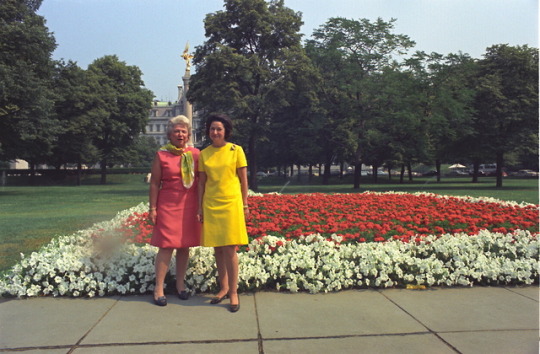
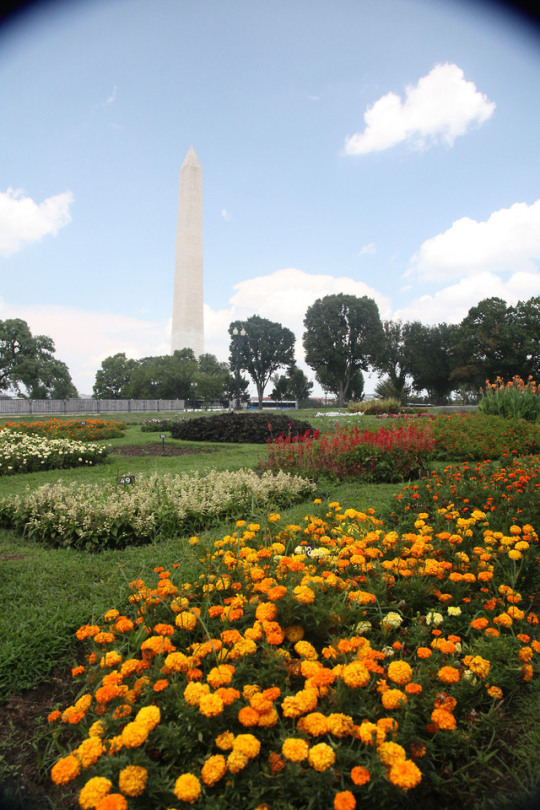

Beautification: A Legacy of Lady Bird Johnson
“The environment after all is where we all meet; where we all have a mutual interest; it is the one thing all of us share. It is not only a mirror of ourselves, but a focusing lens on what we can become.”
- Lady Bird Johnson, “Speech at Yale University,” (New Haven, Connecticut, October 9, 1967).
As a champion of conservation efforts and environmental causes, Lady Bird Johnson initiated the Beautification Project to improve the quality of life for residents of Washington, D.C. through the renewal and improvement of public spaces. The environmental and aesthetic improvements of Beautification included tree-lined avenues, floral displays, design guidelines, improvements to pedestrian circulation, renovation of historic buildings, and litter clean-up.

Beautification Luncheon. Foreground L-R: Sec. Stewart Udall, Lady Bird Johnson, Laurance Rockefeller looking at an architectural model of the Washington DC Mall area during a Beautification Luncheon in the White House State Dining Room. The 1967 luncheon in part discussed proposed changes to the Mall (Robert Knudsen, LBJ Library, White House Photo Office collection (C5209-33).
Beautification was far more complex than a garden club project.
According to Johnson, “Though the word beautification makes the concept sound merely cosmetic, it involves much more: clean water, clean air, clean roadsides, safe waste disposal and preservation of valued old landmarks as well as great parks and wilderness areas. To me…beautification means our total concern for the physical and human quality we pass on to our children and the future.”

Lady Bird Johnson and two young people standing among blooming white azaleas during a Beautification Tour of Washington, D.C. (Robert Knudsen, LBJ Library, C1754-25).
Lady Bird Johnson selected her adopted hometown of Washington, D.C. as the pilot city to show the nation how Beautification could enhance the overall quality of life. The city afforded Johnson the perfect opportunity to showcase the potential of the program. The prominence of Washington, D.C. garnered national visibility to highlight the progress of the effort.
youtube
"The Story of Mrs. Lyndon B. Johnson's Beautification Program" is from the LBJ Library moving picture collection created by the White House Naval Photographic Unit, aka the Navy Films. The films consist of monthly reports on the activities of President and Lady Bird Johnson from 1963-1969. This edited content is from the LBJ Library audiovisual archives.
Lady Bird Johnson formed a coalition of both public and private entities, involving Secretary of the Interior Stewart Udall, local officials, planners, landscape architects, citizens, and school groups.

Spring brings color to the trees on the East Potomac Golf Course at Hains Point in Washington, D.C. (NPS Photo).
Lady Bird’s legacy is still evident in Washington, D.C. today.
Daffodil drifts soften the hillsides of the Rock Creek and Potomac Parkway, as well as the George Washington Memorial Parkway and Lady Bird Johnson Park. Cherry trees line the road of Hains Point, sprays of blossoms frame views in the monumental core, and the Floral Library near the Washington Monument bursts with color in the springtime. Street trees shade avenues throughout the city, and efforts to clean the city’s waterways have continued into the present.
Find more in the full article at nps.gov: Beautification: A Legacy of Lady Bird Johnson
#Cultural Landscape#Washington DC#Beautification#Lady Bird Johnson#Flowers#BeLikeLadyBird#Landscape Architecture#Conservation#Preservation Month#Cherry Blossoms#Spring#Women's History#Environment#First Ladies#NPS#National Park Service#FindYourPark
22 notes
·
View notes
Text
Gnostic Politics - Part II
"My interest in [extraterrestrial intelligence] is prompted by the fact that I have been long concerned with the possibility of expanding man’s spiritual and intellectual potential. This interest stems from a lifetime of concern and support for innovative thinking in fields such as philosophy, holistic healing, science and spirituality. I have become convinced that we must fulfill more of our human potential if we are to cope with the increasing difficult problems which now challenge our quality of life and our very survival." - Laurance Rockefeller, as quoted by Grant Cameron [linked here].
In the summer of 1995, America's dashing new president, Bill Clinton, and First Lady, Hillary Clinton, were summoned to Wyoming to meet with Laurance Rockefeller. The subject? UFO disclosure. Laurance had been stirring up all kinds of trouble, poking his nose in places where he ought not, and even insinuating veiled threats if the government didn't come clean about Roswell.
Or, at least, that's the impression we've been given.
Respected UFO researcher Grant Cameron maintains a wealth of information at his website PresidentialUFO.com on this subject. He has methodically brought together documents and conversations which paint an ever evolving picture of government knowledge about, and interaction with, whatever is "out there." Cameron sat down with Dark Journalist recently and recounted the threads of his research in vivid detail. Near the end of his interview, Cameron made some very telling comments about consciousness that have a direct bearing on the subject of this blog series, Gnostic Politics. More about that farther down the page.
As I listened to Cameron and host Daniel Liszt review the participation of Laurance Rockefeller in the so-called UFO disclosure initiative of 1993, during Clinton's first term in office, a voice in my brain was asking, "Isn't it just a bit ludicrous to believe that the government would have something that the mighty Rockefeller Family didn't already know about?"
For those of you who followed my Antarctica series, you might remember that I devoted an entire article [linked here] to the "Rockefeller Connection" as it relates to the exploration of that continent. In 1926, the Rockefellers financed Admiral Byrd's flight over the North Pole. In fact, one researcher quoted in that article said that Rockefeller was Byrd's "mentor and lifetime financial backer." Indeed, in the post-WWII era of Antarctic exploration, the Rockefeller Foundation became the model by which the government's National Science Foundation would be created. In 1997, the U.S. Navy began handing oversight of America's interests in Antarctica over to the Rockefeller-modeled NSF.
Is it just coincidence that the Rockefellers were making moves to take charge of Antarctica at the exact same time that brother Laurance was busy promulgating the "UFO disclosure" narrative up in Washington, D.C.? Let us not forget that it was Rockefeller's man, Admiral Byrd, who was one of the first men to spark public awareness of UFO's back in 1947 following the Antarctic failure of Operation Highjump.
But there's more.
The Global Mind Arrives in the 1990's
Let's think about what else was taking shape in the 1990's in the field of science and technology, that one huge revolution that has changed all of our lives: the arrival of the Internet and the World Wide Web.
In 1989, the first web site was launched at a place not immediately associated with web sites: CERN. This highly secretive European science project had been developing the Internet with collaboration from other participants, notably, America's own DARPA agency. One of America's most highly honored engineers, Dr. Vannevar Bush, is largely credited with creating the basis of HTML, the hypertext markup language that helped transform the "information superhighway" from just a bunch of text messaging forums into a graphical browsing powerhouse. Those of you who have followed the "UFO Disclosure" movement for the last 10 or 20 years may recall that Vannevar Bush's name always comes up in discussions about the "Majestic-12" documents and the exotic technologies that were "seeded" into America's military industrial complex. Raytheon is, after all, his company.
In fact, Dr. Vannevar Bush (no direct relation to the George Bush family, by the way), had written an essay as far back as 1945 entitled "As We May Think" that foreshadowed the arrival of the digital global mind that we see now being constructed before our eyes. This Wikipedia page [linked here] describes the essay:
"'As We May Think' is a 1945 essay by Vannevar Bush which has been described as visionary and influential, anticipating many aspects of information society. It was first published in The Atlantic in July 1945 and republished in an abridged version in September 1945—before and after the atomic bombings of Hiroshima and Nagasaki. Bush expresses his concern for the direction of scientific efforts toward destruction, rather than understanding, and explicates a desire for a sort of collective memory machine with his concept of the memex that would make knowledge more accessible, believing that it would help fix these problems. Through this machine, Bush hoped to transform an information explosion into a knowledge explosion."
Bush envisioned a machine that he called the Memex [linked here]:
"Bush describes a memex as an electromechanical device enabling individuals to develop and read a large self-contained research library, create and follow associative trails of links and personal annotations, and recall these trails at any time to share them with other researchers. This device would closely mimic the associative processes of the human mind, but it would be gifted with permanent recollection. As Bush writes, 'Thus science may implement the ways in which man produces, stores, and consults the record of the race.'"
In fact, just three years before writing that essay, Bush had built a bit of a machine-brain in 1942 and it was named for its backer, the Rockefellers [linked here]:
Rockefeller Differential Analyzer - The RDA was operational in 1942, a year after the Zuse Z3. It was equipped with 2000 vacuum tubes, weight 100 tons, used 200 miles of wire, 150 motors and thousand of relays. According to historian Robin Boast, "the RDA (Rockefeller Differential Analyzer) was revolutionary, and later was considered to be one of the most important calculating machines of the Second World War."
With those statements above by Dr. Bush, now we are beginning to see a vision taking shape of the development of Artificial Intelligence. If you've been following the research of Quinn Michaels, then you know how the trail of the #AI network known as #Tyler leads back to that same period when the Nazi "Paperclip" scientists came to Ft. Bliss, Texas.
The point of reviewing this techno history is to suggest that, when Hillary Clinton took her stroll with Laurance Rockefeller at Jackson Hole, Wyoming in 1995, there was likely much more than UFO's on Rockefeller's mind. In 1995, the World Wide Web was positioning itself to become a household word. Satellite communication and fiber optic cable were on the brink of transforming the lives of every man, woman, and child on the planet. The Rockefellers were deeply invested in the information revolution and had been involved with all manner of advanced government research via foundations and universities throughout the entire 20th century.
Furthermore, when you consider the arguments that Joseph P. Farrell poured into his book "Roswell and the Reich," and the conclusions he reached to the effect that what the U.S. government was primarily covering up was the fact that the post-war Nazi elite were operating UFO's as a rogue, breakaway community, it makes sense that Laurance would continue to promote a public narrative bent on continuing that diversion.
Part of that diversionary narrative might also have included the need to obfuscate the true source of the radically new technology. The "extraterrestrial" component in the narrative might actually be true, but not in the way that all the sci-fi movies have led you to believe.
"The material world is secondary to consciousness."
This is where Grant Cameron's statement can be inserted as a bookmark into this discussion. He reviews the conclusions that the Canadian government reached in the 1950's about the U.S. Deep State intel relative to the UFO issue. Once again, Dr. Vannevar Bush's name came up, but note also the interesting point #5 below about mental phenomena. Cameron has a full page about this at his website [linked here]. Note, also, that there is nothing here that refers explicitly to "aliens":
1) The matter is the most highly classified subject in the United States Government, rating higher than even the H-bomb.
2) Flying saucers exist.
3) Their modus operandi is unknown but concentrated effort is being made by a small group headed by Vannevar Bush.
4) The entire matter is considered by the United States authorities to be of tremendous significance.
5) The United States authorities are investigating along quite a number of lines, which might possibly be related to the saucers such as mental phenomena.
At the 2-hour, 6-minute mark of this recent interview, Liszt and Cameron further comment:
Liszt: "You've come to the conclusion that most of the UFO phenomenon is about consciousness?"
Cameron: "That's what it comes down to. That's the whole bottom line.... 14% of all experiencers claim that you fly the flying saucer with your mind. It comes down to an idea about 'Is the world made of nuts and bolts, or is it made of consciousness?' And I say it's made of consciousness. The material world is secondary to consciousness."
Hold that thought, "The material world is secondary to consciousness," on the back burner for the next blog. That statement is not a bad summary of a 2,000 year old heretical belief system known as "Gnosticism." Near the beginning of the 20th century, a Jesuit priest named Pierre Teilhard de Chardin would incur the wrath of the non-Jesuit Papacy by likewise evangelizing a humanist evolution in consciousness. One critic of Teilhard named Laura Kimball [linked here] recently described him as "an evolutionary scientist, New Age Hindu-style pantheist and occult Hermetic and alchemical magician who, on behalf of his Great Work, sought fusion of opposites, for example..., of man with Omega point, the very substance of God." Hmmm, sounds like he would have gotten along great with Ray Kurzweil.
Teilhard would follow a path similar to Admiral Byrd and Dr. Vannevar Bush in that he benefited from the financial largesse of the Rockefellers in a field of study about as far removed from Artificial Intelligence as you can imagine.
Or so it would seem, until you look at the Teilhard story more closely. And this time it may be that the Jesuit Order was pulling the strings of the Rockefellers rather than the other way around. In the next blog, we'll take a look at how his gospel of the Noosphere influenced the Transhumanist quest in which the world now finds itself engaged.
My Twitter contact information is found at my billboard page of SlayTheBankster.com. Listen to my radio show, Bee In Eden, on Youtube via my show blog at SedonaDeb.wordpress.com.
#LAURANCE ROCKEFELLER#HILLARY CLINTON#VANNEVAR BUSH#GRANT CAMERON#DARK JOURNALIST#NOOSPHERE#MATERIAL WORLD#CONSCIOUSNESS#GNOSTICISM#TEILHARD#JESUIT#WORLD WIDE WEB#INTERNET#CERN#AI#MEMEX#GLOBAL MIND#INFORMATION SUPERHIGHWAY#MJ-12#MAJESTIC-12#UFO#ET
0 notes
Photo
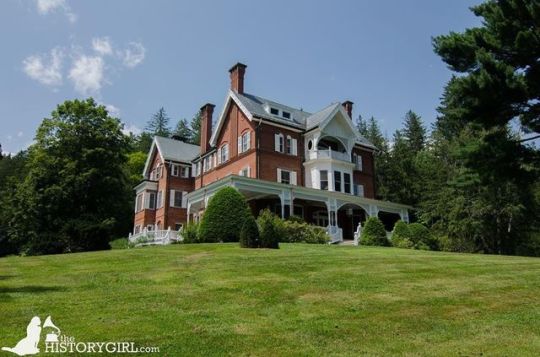
Today I toured @marshbillingsnps in Woodstock, #Vermont. The park preserves the site where Frederick Billings established a managed forest and practiced #stewardship principles. The name honors Billings and the other owners of the property: George Perkins Marsh, Mary Montagu Billings French, Laurance Rockefeller, and Mary French Rockefeller. The house was originally built in 1805 for the growing Marsh family. In 1869, the house was sold to Frederick Billings and he undertook dramatic renovations which transformed the property into the Stick Style. In 1885, Billings once again remodeled the home; this time in the newly-fashionable Queen Anne style. The house and a surrounding 40 acres of land were designated a National Historic Landmark and listed on the @NationalRegisterNPS in 1967. The Rockefellers transferred the property to @NationalParkService on August 26, 1992 and it opened to the public in 1998. This trip was sponsored by @mmbuilds. #vt #vthistory #SpreadTheHistory #nps #nps102 #goparks #nationalpark #nationalparks #nationalparkservice #goparks #americanhistory #nationalparkgeek #travelblog #travelblogger #explore #blog #blogger #exploregeorgia #architecture #archi_ologie #oldhouselove #smallparksaturday #marshbillingsrockefellernationalhistoricalpark #nrhp #queenanne #woodstockvt #woodstock (at Marsh-Billings-Rockefeller National Historical Park) https://www.instagram.com/p/B0uRVhZHJnW/?igshid=s6duco31aflt
#vermont#stewardship#vt#vthistory#spreadthehistory#nps#nps102#goparks#nationalpark#nationalparks#nationalparkservice#americanhistory#nationalparkgeek#travelblog#travelblogger#explore#blog#blogger#exploregeorgia#architecture#archi_ologie#oldhouselove#smallparksaturday#marshbillingsrockefellernationalhistoricalpark#nrhp#queenanne#woodstockvt#woodstock
1 note
·
View note
Text
16 Reasons Why Landscape Architecture is More Important
These 16 justifications for why landscape architecture is a higher priority than you suspect will carry you nearer to the center of the calling. Each individual who is even in the smallest touch with landscape design realizes that this calling's field is extraordinarily wide. Furthermore, when something is that intricate, it should be significant, correct? Here is a not-really short rundown of reasons that show the significance of landscape engineering. The intricacy of the calling is isolated into six classifications in this article, so it will be simpler for you to understand every one of the reasons. Presently, we should take a quick trip and see what's going on with this rundown. Appreciate!
Landscape Architecture is More Important Than You Think. In this article we will be discussing the 8 reasons Why landscape architecture is important & next 8 in the part 2.
CLIMATE
Assessing the nature of the landscape and deciding remediation necessities Before beginning with the improvement of the plan, the site should be evaluated. This implies assessment of the site's qualities and pollution. It's an extremely mind boggling process which incorporates input from experts like specialists, biologists, and landscape modelers. landscape modelers distinguish areas of chance or misfortunes that might give limitations, and furthermore assess parts of the landscape (topography, hydrology, grand qualities, and so on.). With the evaluating of the site we get data, for example, whether a site is ok for development and which moves ought to be made for that site's remediation and association.
PROTECTION OF THE CLIMATE
As the worldwide cognizance about the safeguarding of the climate is rising, the significance of landscape engineering is likewise going upwards extremely quick. There are a lot of landscape projects on the planet that are about natural environment. Other than bringing new answers for a wide range of existing ecological issues, Architecture Companies in Delhi additionally work to safeguard and protect immaculate normal fortunes. An ideal illustration of the conservation of nature is Laurance S. Rockefeller Preserve, which shows us how one public park can be adjusted between solid climate, excellence, and human necessities.
CREATING REASONABLE METHODS FOR THE CLIMATE
This is where we really want to talk about "manageability". However, what is it, as a matter of fact? It addresses comprehensive techniques which are making our current circumstance better and more clean. landscape engineering plays a significant part in this work on, beginning with energy saving and going the whole way to water cleaning.
RECOVERY OF DIRTIED REGIONS
Many districts of the world have been exposed to some sort of contamination, especially assuming that there are processing plants situated there. No matter what the way that plants are essential for our endurance, we as a whole are aware of their adverse consequence on natural wellbeing. Contingent upon the sort of plant, the encompassing region could remain debased for quite a long time after the office is shut. Luckily the outcomes can be removed, obviously with a ton of work in tidying up, finishing, and appropriate planting. Investigate Westergasfabriek Park to perceive how a significant tidy up was effectively achieved in this intensely contaminated area of Amsterdam.
STORMWATER THE EXECUTIVES
Stepping further into manageability, obviously water the board is an absolute necessity talk about subject. We are confronted with the corruption of environments, environment changes, and managing water can some of the time be a main problem. As it is known, wetlands are imperiled, and it's a major issue since they are naturally exceptionally assorted, purge the stormwater, and control the floods. With the guide of landscape designers, these biological systems can be revived and resurrected; projects like Qunli Stormwater Park lead focused of stormwater the board. The use of water can be worked on beyond the wetland as well!
CLEANING THE DIRT AND WATER
Due to expanded soil defilement, the world needed to think of a savvy answer for its cleaning. You presumably currently speculated that the arrangement is phytoremediation. In specific regions the dirt is seriously debased with weighty metals and other harmful materials, and that implies that the underground waters are imperiled as well. Use of plants as regular remediators decidedly affects the dirt since they're fit for taking in the toxins, concentrating them and utilizing them in their tissues.
ADDING TO AIR FILTRATION
We know that trees (and vegetation overall) assume an indispensable part in air purifying. As well as delivering oxygen, leaves likewise ingest dirtying gases exhaustive their stomata, which effectively clean the air and work on its quality. Furthermore the worry over open air quality, the indoor air ought to be plant-sanitized as well, and NASA has done broad exploration regarding that matter.
NORMAL MATERIALS ARE GENERALLY WELCOME
As landscape draftsmen we're endeavoring to save our current circumstance, and while chipping away at some task we're attempting to make it as viable with nature as could really be expected. This implies execution of regular materials any place reasonable - whether in clearing, seating, enrichments, and so on. You can now easily Buy Indian Paintings Online Obviously, the reason and capacity of the undertaking will direct which materials we'll utilize, however normally it's feasible to somewhat carry out wood or regular stone at any rate. Two tasks that absolutely advance the use of regular materials are The Banjaran Hotsprings Retreat and Hasomrim Park.
Now that you have come this long, you are interested to learn more about landscape architecture. Stay tuned for the part 2
0 notes
Photo

Great price on this 2020-D Marsh Billings Rockefeller National Historical Park Quarter ONLY: $2.25 2020-D Marsh Billings Rockefeller National Historical Park QuarterUncirculatedThe Marsh-Billings-Rockefeller National Historical Park in Vermont is the only national park dedicated to telling the story of conservation history and the evolving nature of land stewardship in America. It was the boyhood home of George Perkins Marsh, one of America’s first conservationists, and later the home of Frederick Billings. The property was given to the American people by its most recent owners, Laurance S. and Mary French Rockefeller.The reverse (tails) design depicts a young girl completing the planting of a Norway spruce seedling near an established tree, continuing the life cycle of the forest. The child represents the conservationist, seeking to maintain a sustainable forest for future enjoyment and education. https://www.thecoinshop.shop/national-park-quarters/2020-d-marsh-billings-rockefeller-national-historical-park-quarter View MORE National Park Quarters https://www.thecoinshop.shop/national-park-quarters
0 notes
